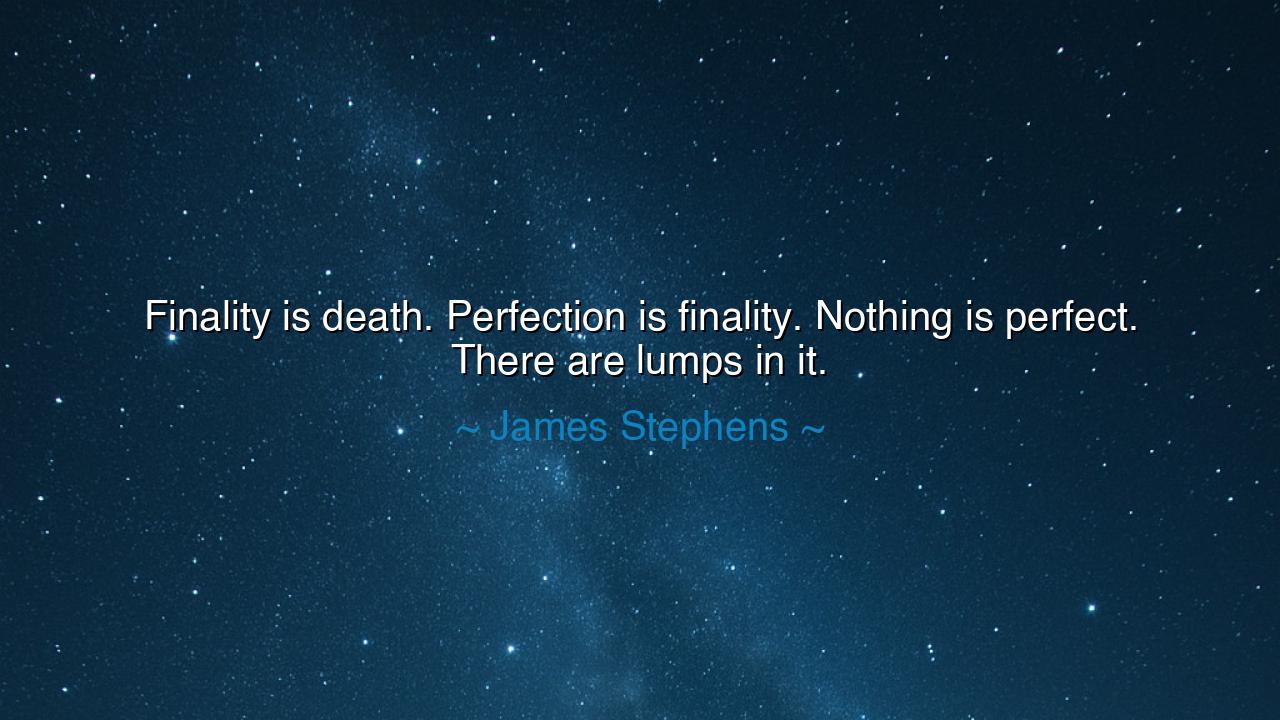
Finality is death. Perfection is finality. Nothing is perfect.






“Finality is death. Perfection is finality. Nothing is perfect. There are lumps in it.” — thus spoke James Stephens, the Irish poet and philosopher, whose words are as rough-hewn as the truth they bear. In these lines, he reminds us of the sacred imperfection of life, the truth that change and flaw are the very signs of vitality. For to reach perfection, to attain absolute completion, would be to reach an end — and every end is a kind of death. Life, therefore, is not a smooth marble statue, cold and still, but a living, breathing, flawed creation — ever-shifting, ever-growing, filled with “lumps,” as Stephens says, that make it real.
In the spirit of the ancients, this saying would have been uttered by a sage upon a mountain — not to dishearten the listener, but to free them. For in the pursuit of perfection, men often lose the joy of becoming. The Greeks, who sought harmony in all things, knew that motion is life. To move is to be imperfect; to err is to evolve. When a river ceases to flow, it becomes stagnant; when the flame burns too still, it dies. So it is with the human soul — the moment it declares itself “finished,” it begins to decay. The “lumps” of which Stephens speaks are the signs of the ongoing act of creation — the uneven texture of a soul still alive.
The poet’s words were forged in an age of great artistic awakening — Ireland, in the early 20th century, when dreamers and writers sought to define a national spirit. Stephens, standing among them, saw how people yearned for purity — for the perfect poem, the perfect ideal, the perfect world. But he, being wiser, understood that such longing, though noble, can turn to poison if taken too far. The quest for perfection is a beautiful madness that blinds the heart to the wonder of what already is. The artist who keeps chiseling his sculpture may find, at last, that he has carved it away to nothing.
Consider the story of Leonardo da Vinci, whose genius knew no bounds, yet whose heart was never satisfied. He left countless works unfinished — the Adoration of the Magi, the Battle of Anghiari, and even the Mona Lisa, which he carried with him until his death, still retouching it. Leonardo knew, perhaps unconsciously, the truth of Stephens’s words: that perfection is finality, and to finish something completely is to cease its life. His art lived because it remained in motion, always unfolding, always searching. The “lumps” — the rough brushstrokes, the shadows unresolved — are what make his work human, and therefore eternal.
Stephens’s insight is not limited to art; it speaks to every sphere of existence. Relationships, too, are “lumpy” — filled with misunderstanding, forgiveness, and growth. A friendship or a love that demands perfection will crumble beneath the weight of expectation. The wise learn to love the unevenness, for it is the evidence of humanity. Even the seasons of life — youth and age, joy and sorrow — are imperfectly balanced. Yet in that imperfection lies beauty, for the rhythm of life is not a straight line but a heartbeat, rising and falling.
The ancients would call this the wisdom of becoming. They taught that perfection belongs only to the gods, and that mortals, in their striving, should seek excellence but not flawlessness. To be perfect would be to leave the realm of the living. Thus, the wise man accepts imperfection as the sacred texture of the world. He knows that every flaw is a lesson, every crack a door through which light enters. He is not defeated by the “lumps” of life — he embraces them, for they are the fingerprints of creation itself.
So, my listener, take this teaching to heart: do not fear imperfection; fear stagnation. Do not polish your soul until it gleams lifelessly; let it bear the marks of growth, the scars of struggle, the uneven beauty of living truthfully. Strive, yes — but know that perfection is not your destiny. To be alive is to be unfinished, and to be unfinished is divine. As James Stephens declared, finality is death — so long as you are imperfect, you are still alive. Cherish your “lumps,” for they are the signs that your spirit still moves, still dreams, still dares to become.






AAdministratorAdministrator
Welcome, honored guests. Please leave a comment, we will respond soon